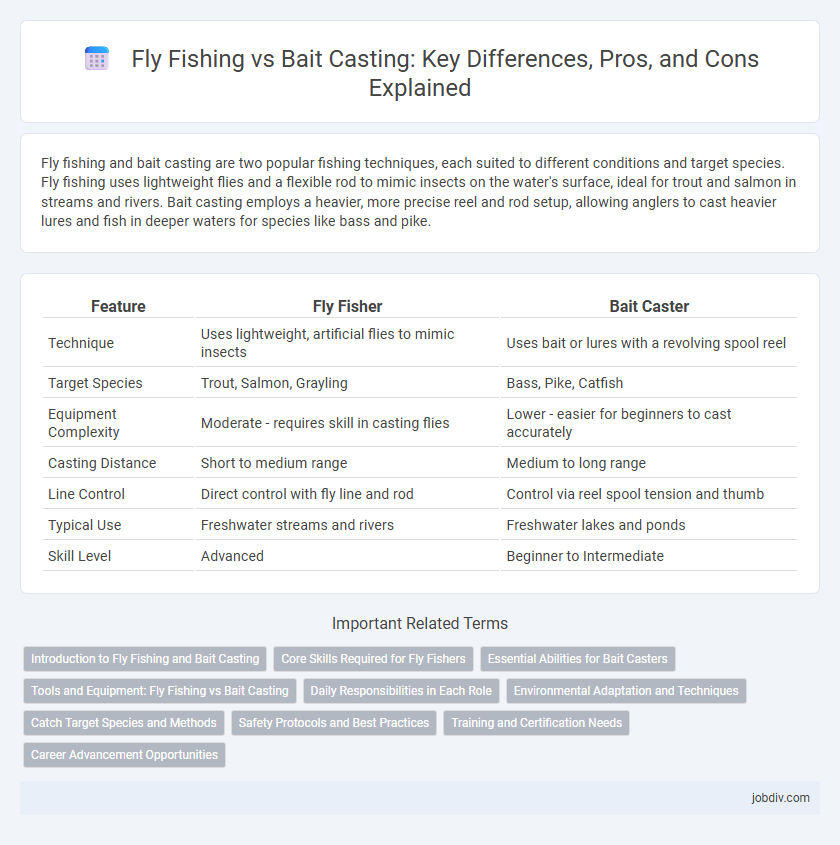Fly fishing and bait casting are two popular fishing techniques, each suited to different conditions and target species. Fly fishing uses lightweight flies and a flexible rod to mimic insects on the water's surface, ideal for trout and salmon in streams and rivers. Bait casting employs a heavier, more precise reel and rod setup, allowing anglers to cast heavier lures and fish in deeper waters for species like bass and pike.
Table of Comparison
| Feature | Fly Fisher | Bait Caster |
|---|---|---|
| Technique | Uses lightweight, artificial flies to mimic insects | Uses bait or lures with a revolving spool reel |
| Target Species | Trout, Salmon, Grayling | Bass, Pike, Catfish |
| Equipment Complexity | Moderate - requires skill in casting flies | Lower - easier for beginners to cast accurately |
| Casting Distance | Short to medium range | Medium to long range |
| Line Control | Direct control with fly line and rod | Control via reel spool tension and thumb |
| Typical Use | Freshwater streams and rivers | Freshwater lakes and ponds |
| Skill Level | Advanced | Beginner to Intermediate |
Introduction to Fly Fishing and Bait Casting
Fly fishing utilizes lightweight, artificial flies and specialized fly rods to mimic insects on the water's surface, offering a more delicate and artistic approach to angling. Bait casting employs heavier bait and lures with a baitcasting reel, allowing for increased casting distance and accuracy, ideal for targeting larger fish species. Both techniques require distinct skills and gear, with fly fishing emphasizing finesse and bait casting focusing on power and control.
Core Skills Required for Fly Fishers
Mastering precise casting techniques and controlling the fly line are core skills required for fly fishers to effectively mimic insect movements on water surfaces. Fly fishers must develop keen observation skills to read water currents and identify fish behavior, which enhances presentation accuracy. Proficiency in knot tying and fly selection tailored to specific fishing environments significantly increases catch success in fly fishing.
Essential Abilities for Bait Casters
Mastering bait casters requires precise thumb control to prevent backlash and achieve accurate casts, especially in heavy cover environments. Anglers must develop a strong understanding of spool tension adjustment to optimize lure presentation and maintain line control during strikes. Quick reflexes and steady hands are essential for setting the hook effectively and managing powerful fish on the retrieve.
Tools and Equipment: Fly Fishing vs Bait Casting
Fly fishing utilizes lightweight fly rods, flexible fly lines, and delicate artificial flies designed to mimic insects, emphasizing precision and stealth. Bait casting relies on robust bait caster reels, heavier rods, and a variety of live bait or lures, providing greater casting distance and control for targeting larger fish. The selection of tools and equipment directly impacts the fishing technique and effectiveness in different water conditions and fish species.
Daily Responsibilities in Each Role
Fly fishers meticulously select and cast lightweight artificial flies to mimic insects, requiring skillful rod manipulation and continuous observation of water conditions. Bait casters handle heavier lures and manage line control with precision, often adjusting drag settings and casting techniques to target specific fish species. Both roles demand regular maintenance of gear and adaptability to environmental changes for successful daily fishing outcomes.
Environmental Adaptation and Techniques
Fly fishing excels in clear, fast-moving streams where precise presentation of artificial flies mimics natural insects, requiring skillful casting techniques to avoid spooking fish. Bait casting is better suited for diverse water conditions, including murky lakes and deep rivers, allowing anglers to use heavier lures and target larger species with controlled, powerful casts. Both methods demand specific gear adaptations to optimize performance in their respective environments, enhancing fish-catching efficiency.
Catch Target Species and Methods
Fly fishing targets species like trout, salmon, and bass using lightweight flies that mimic insects, relying on casting techniques to present the fly delicately on the water surface. Bait casting is effective for catching larger, aggressive species such as pike, muskie, and bass by casting heavier lures and using precise control for accurate placement. The choice between fly fishing and bait casting depends on the targeted species' behavior and preferred habitats, with fly fishing excelling in clear, shallow waters and bait casting suited for deeper, structure-heavy environments.
Safety Protocols and Best Practices
Fly fishing requires careful handling of sharp hooks and precise casting techniques to avoid injury, emphasizing the importance of wearing protective eyewear and maintaining a safe casting distance. Bait casting demands vigilance in spool control to prevent backlash, with best practices including regular equipment inspection and secure bait attachment to reduce accidents. Both methods prioritize environmental stewardship by adhering to catch-and-release guidelines and proper disposal of fishing line to protect aquatic habitats.
Training and Certification Needs
Fly fishing requires specialized training to master casting techniques and entomology knowledge, often supported by certification programs like the Federation of Fly Fishers' courses. Bait caster fishing demands practice to develop precise casting and reel control skills, with certifications less common but available through local angling clubs or sport fishing schools. Both methods benefit from structured training to enhance technique, safety, and fish conservation awareness.
Career Advancement Opportunities
Fly fishing and bait casting each offer distinct career advancement opportunities within the fishing industry. Fly fishing careers often emphasize specialized skills in guiding, conservation, and niche markets like eco-tourism, while bait casting roles may lead to broader positions in commercial fishing, equipment sales, or tournament fishing. Mastery of either technique can open paths to education, product development, and influential roles in fishing organizations.
Fly Fisher vs Bait Caster Infographic

 jobdiv.com
jobdiv.com